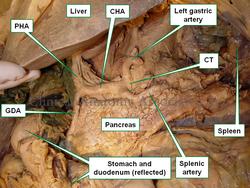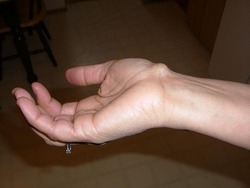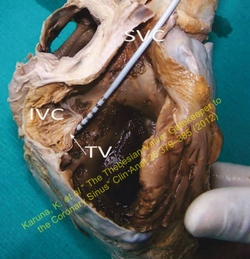
Medical Terminology Daily (MTD) is a blog sponsored by Clinical Anatomy Associates, Inc. as a service to the medical community. We post anatomical, medical or surgical terms, their meaning and usage, as well as biographical notes on anatomists, surgeons, and researchers through the ages. Be warned that some of the images used depict human anatomical specimens.
You are welcome to submit questions and suggestions using our "Contact Us" form. The information on this blog follows the terms on our "Privacy and Security Statement" and cannot be construed as medical guidance or instructions for treatment.
We have 817 guests online

Jean George Bachmann
(1877 – 1959)
French physician–physiologist whose experimental work in the early twentieth century provided the first clear functional description of a preferential interatrial conduction pathway. This structure, eponymically named “Bachmann’s bundle”, plays a central role in normal atrial activation and in the pathophysiology of interatrial block and atrial arrhythmias.
As a young man, Bachmann served as a merchant sailor, crossing the Atlantic multiple times. He emigrated to the United States in 1902 and earned his medical degree at the top of his class from Jefferson Medical College in Philadelphia in 1907. He stayed at this Medical College as a demonstrator and physiologist. In 1910, he joined Emory University in Atlanta. Between 1917 -1918 he served as a medical officer in the US Army. He retired from Emory in 1947 and continued his private medical practice until his death in 1959.
On the personal side, Bachmann was a man of many talents: a polyglot, he was fluent in German, French, Spanish and English. He was a chef in his own right and occasionally worked as a chef in international hotels. In fact, he paid his tuition at Jefferson Medical College, working both as a chef and as a language tutor.
The intrinsic cardiac conduction system was a major focus of cardiovascular research in the late nineteenth and early twentieth centuries. The atrioventricular (AV) node was discovered and described by Sunao Tawara and Karl Albert Aschoff in 1906, and the sinoatrial node by Arthur Keith and Martin Flack in 1907.
While the connections that distribute the electrical impulse from the AV node to the ventricles were known through the works of Wilhelm His Jr, in 1893 and Jan Evangelista Purkinje in 1839, the mechanism by which electrical impulses spread between the atria remained uncertain.
In 1916 Bachmann published a paper titled “The Inter-Auricular Time Interval” in the American Journal of Physiology. Bachmann measured activation times between the right and left atria and demonstrated that interruption of a distinct anterior interatrial muscular band resulted in delayed left atrial activation. He concluded that this band constituted the principal route for rapid interatrial conduction.
Subsequent anatomical and electrophysiological studies confirmed the importance of the structure described by Bachmann, which came to bear his name. Bachmann’s bundle is now recognized as a key determinant of atrial activation patterns, and its dysfunction is associated with interatrial block, atrial fibrillation, and abnormal P-wave morphology. His work remains foundational in both basic cardiac anatomy and clinical electrophysiology.
Sources and references
1. Bachmann G. “The inter-auricular time interval”. Am J Physiol. 1916;41:309–320.
2. Hurst JW. “Profiles in Cardiology: Jean George Bachmann (1877–1959)”. Clin Cardiol. 1987;10:185–187.
3. Lemery R, Guiraudon G, Veinot JP. “Anatomic description of Bachmann’s bundle and its relation to the atrial septum”. Am J Cardiol. 2003;91:148–152.
4. "Remembering the canonical discoverers of the core components of the mammalian cardiac conduction system: Keith and Flack, Aschoff and Tawara, His, and Purkinje" Icilio Cavero and Henry Holzgrefe Advances in Physiology Education 2022 46:4, 549-579.
5. Knol WG, de Vos CB, Crijns HJGM, et al. “The Bachmann bundle and interatrial conduction” Heart Rhythm. 2019;16:127–133.
6. “Iatrogenic biatrial flutter. The role of the Bachmann’s bundle” Constán E.; García F., Linde, A.. Complejo Hospitalario de Jaén, Jaén. Spain
7. Keith A, Flack M. The form and nature of the muscular connections between the primary divisions of the vertebrate heart. J Anat Physiol 41: 172–189, 1907.
"Clinical Anatomy Associates, Inc., and the contributors of "Medical Terminology Daily" wish to thank all individuals who donate their bodies and tissues for the advancement of education and research”.
Click here for more information
- Details
In Greek mythology [Atlas] is the son of Iapetus and Clymene, said to bear on his shoulders the weight of the world. Since the depiction of Atlas supporting the world appears in all early cartography books, these books were called atlases. With time, any book with a large number of pictures came to be known as an "atlas".
The [atlas] is a name used for the first cervicalvertebra, since this vertebra bears the weight of the head. The atlas is an atypical vertebra as it does not have a vertebral body and is composed by an anterior and a posterior arch. As a cervical vertebra, the atlas does have two lateral foramina transversaria, for the passage of the vertebral artery. The image depicts a superior view of the atlas and the articular surfaces for the atlantooccipital joint can be seen.
If you hover over the image, a posterior view of the atlas will appear and you will see in the midline the articular surface for the atlantoaxial joint. For a larger version of both images, click on the legends below the image
Images property of: CAA.Inc. Photographer: D.M. Klein
- Details
The [gastroduodenal artery] arises from the common hepatic artery, which itself is a branch of the celiac trunk. Immediately after the gastroduodenal artery arises, the common hepatic artery changes its name to proper hepatic artery.
The gastroduodenal artery courses inferiorly, passing posterior to the first portion of the duodenum, and descends dividing into the anterosuperior and posterosuperior pancreaticoduodenal arteries. These branches provide supply to the duonenum and pancreas.
An ulcer of the posterior aspect of the first portion of the duodenum is dangerous, for if undiagnosed and untreated, could perforate into the gastroduodenal artery, which can bleed uncontrolled into the duodenum.
The image is an anteroinferior view of the liver and stomach. The duodenum and stomach are reflected anteriorly. CT= Celiac trunk, CHA= Common hepatic artery, PHA= Proper hepatic artery, GDA= Gastroduodenal artery
Image property of: CAA.Inc. Photographer: David M. Klein
- Details
A [cyst] is a small sac-like structure, usually characterized by a distinct membrane that separates the content from its surroundings. It usually contains serous fluid, but it can also contain semisolid materials. If the cyst contains pus, then it will be called an "abscess".
There are many types of cysts. One of them, shown in the accompanying image is a "ganglion cyst", a serous accumulation of fluids that is usually found near a joint or a tendon in the hands or feet. You can also read the article on "Nabothian cysts".
The image shows a ganglion cyst in the anterior aspect of the wrist.
The same word can be used as a root term, [-cyst-] arises from the Greek word [κύστη], pronounced(kisti), meaning "bladder". It is used in many words such as:
- Cholecystectomy: Removal of the gallbladder
- Cystic duct: The evacuation duct of the gallbladder
- Dacryocystolithiasis: Presence of stones in the lacrimal sac
- Cystoscope: An instrument to view into the urinary bladder
- Cystitis: Inflammation or infection of the urinary bladder
There is similar root term used for bladder: [-vesic] from the Latin [vesicae], also meaning "bladder".
Original image by GEMalone (Own work) [GFDL (http://www.gnu.org/copyleft/fdl.html) or CC BY 3.0 (http://creativecommons.org/licenses/by/3.0)], via Wikimedia Commons. Public domain.
- Details
Hesselbach’s triangle is a triangular region in the lower posterior aspect of the anterior abdominal wall (see yellow inset in the image). It is bound medially by the lateral border of the rectus abdominis muscle, superolaterally by the inferior (deep) epigastric vessels (label “C”) and by the inguinal ligament inferolaterally.
Hesselbach’s triangle is described as the area where a direct inguinal hernia will extrude from posterior to anterior, to protrude directly (hence the name) through the external (superficial) inguinal ring.
Franz Kaspar Hesselbach (1759-1816) was a German surgeon and anatomist who described inguinofemoral hernias in detail, publishing several books on the subject. His name is attached to several regions and structures:
• Hesselbach’s triangle, described in this article
• Hesselbach’s fascia. Known as the cribriform fascia, this perforated fascia covers the saphenous opening in the superior femoral region.
• Hesselbach’s ligament. Also known as the interfoveolar ligament, this is a thickening of the transversalis fascia in relation to the inferior (deep) epigastric vessels.
If you click on the picture, an original image by Hesselbach will appear. This image shows a defect in Hesselbach’s triangle, setting the stage for a direct inguinal hernia, as well as the interfoveolar ligament. Incidentally, Hesselbach's triangle as described today is not the area described originally by Dr. Hesselbach, where the lower border of the triangle was Cooper's ligament.
Initial image property of:CAA.Inc.. Artist:M. Zuptich. Secondary image by F.K. Hesselbach.
Clinical anatomy of the inguinofemoral hernias, as well as abdominal and perineal hernias are some of the lecture topics developed and delivered to the medical devices industry by Clinical Anatomy Associates, Inc. For more information Contact Us.
- Details
The suffix [-plasia] originates from the Greek word [plasis] or [plassein], meaning "to form", or "to develop". In medical terminology the suffix [-plasia] is used to mean "development". Here are some applications of this term:
- Aplasia: the prefix [a-] means "absence of" or "no", therefore "no development", or "no formation"
- Dysplasia: the prefix [dys-] means "abnormal" - abnormal development
- Hyperplasia: the prefix [hyper-] means "excessive" - excessive development
- Neoplasia: the prefix [neo-] means "new", therefore "a new development" or a "new formation". The term [neoplasia] is used to denote a malignant condition, a cancer tumor.
- Details
UPDATED: The eponymic [Thebesian valve], or valve of the coronary sinus is a fold of endocardial tissue situated at the exit ostium of the coronary sinus. Named after Adam Christian Thebesius, the morphology of the valve presents with anatomical variations that go from total absence (see image here) to endocardial folds that cover up to 65% of the coronary sinus opening (see image in this article). The variations of the Thebesian valve include fenestrations, cribiriform valves, and the presence of pectineal cardiac muscle.
The Thebesian valve is important because it can be an obstruction to the passage of a catheter performing retrograde cardioplegia in electrophysiological studies, catheter ablation, and percutaneous mitral valve repair.
Thanks to Dr. Karuna Katti for allowing us the use of the image in this article. The image shows the interior of the right atrium with the inferior vena cava removed to demonstrate the Thebesian valve. In this case, the Thebesian valve covers >65% of the coronary sinus ostium. A catheter is being passed from the superior vena cava into the coronary sinus ostium.
The image shown a human heart with the right atrium and ventricle opened. VC, inferior vena cava; SVC, superior vena cava; TV, Thebesian valve.
Source:"The Thebesian Valve: Gatekeeper to the Coronary Sinus"Karuna Katti and Nikhil Prakash PatilClin Anat 25:379–385 (2012)






